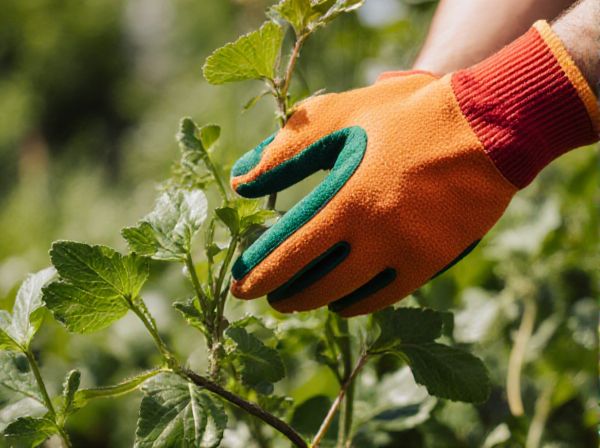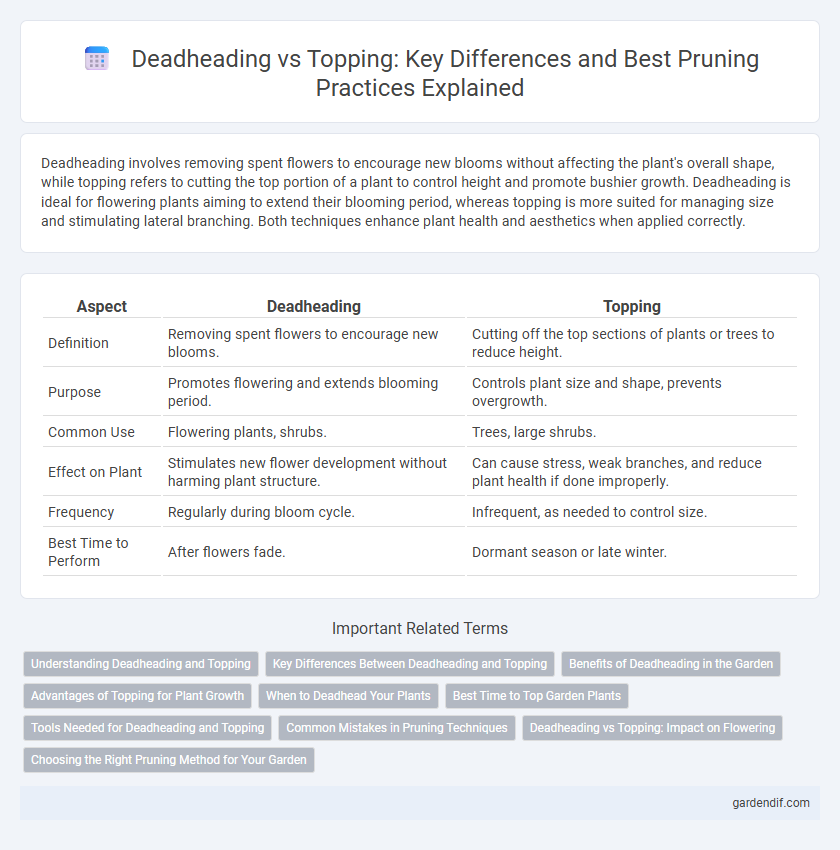
Deadheading vs Topping Illustration
Deadheading involves removing spent flowers to encourage new blooms without affecting the plant's overall shape, while topping refers to cutting the top portion of a plant to control height and promote bushier growth. Deadheading is ideal for flowering plants aiming to extend their blooming period, whereas topping is more suited for managing size and stimulating lateral branching. Both techniques enhance plant health and aesthetics when applied correctly.
Table of Comparison
| Aspect | Deadheading | Topping |
|---|---|---|
| Definition | Removing spent flowers to encourage new blooms. | Cutting off the top sections of plants or trees to reduce height. |
| Purpose | Promotes flowering and extends blooming period. | Controls plant size and shape, prevents overgrowth. |
| Common Use | Flowering plants, shrubs. | Trees, large shrubs. |
| Effect on Plant | Stimulates new flower development without harming plant structure. | Can cause stress, weak branches, and reduce plant health if done improperly. |
| Frequency | Regularly during bloom cycle. | Infrequent, as needed to control size. |
| Best Time to Perform | After flowers fade. | Dormant season or late winter. |
Understanding Deadheading and Topping
Deadheading involves removing spent flowers to promote continuous blooming and prevent seed formation, enhancing overall plant health and appearance. Topping refers to cutting the main stem or branches to control size, encourage bushier growth, and increase yield in certain plants. Both techniques serve distinct purposes in pruning, with deadheading focusing on flower maintenance and topping aimed at structural control.
Key Differences Between Deadheading and Topping
Deadheading involves removing spent flowers to promote continuous blooming, while topping cuts back the main stem to encourage bushier growth and control plant height. Deadheading targets flowering parts without significantly altering plant structure, whereas topping reshapes the plant's overall form and can stimulate lateral branching. Understanding these key differences helps gardeners choose the appropriate pruning technique to enhance plant health and aesthetics.
Benefits of Deadheading in the Garden
Deadheading promotes continuous flowering by removing spent blooms, which redirects the plant's energy towards new growth and enhances overall garden aesthetics. It reduces the risk of disease by preventing seed formation and decay, maintaining a healthier plant environment. Regular deadheading encourages fuller, more vibrant plants, increasing their lifespan and bloom density compared to topping, which can stress plants and hinder flowering.
Advantages of Topping for Plant Growth
Topping promotes vigorous plant growth by stimulating branching and increasing overall foliage density, which enhances photosynthesis and nutrient absorption. This technique helps maintain a manageable plant size while encouraging the development of stronger stems and improved structural integrity. Compared to deadheading, topping supports faster recovery and sustained vegetative growth, crucial for maximizing yield in many garden and agricultural settings.
When to Deadhead Your Plants
Deadheading is best performed when flower blossoms begin to wilt and fade, signaling the end of their blooming cycle. Removing spent flowers promptly encourages continued blooming and prevents seed formation that can sap plant energy. For optimal growth, deadhead annually or throughout the growing season, depending on plant species and climate conditions.
Best Time to Top Garden Plants
The best time to top garden plants is during their active growing season, typically in late spring to early summer, to encourage bushier growth and prevent excessive height. Topping after the plants have developed a strong root system ensures faster recovery and reduces stress. Avoid topping during dormancy or late fall to prevent damage and minimize vulnerability to pests and diseases.
Tools Needed for Deadheading and Topping
Deadheading requires tools such as pruning shears or scissors to carefully remove spent flowers without damaging the plant, ensuring precise cuts near the stem base. Topping involves using heavier-duty equipment like loppers or pruning saws to cut back larger branches, promoting bushier growth and controlling plant height. Both methods benefit from sterilized tools to prevent disease transmission and maintain plant health.
Common Mistakes in Pruning Techniques
Deadheading removes spent flowers to encourage continuous blooming without cutting into the main structure, whereas topping involves cutting back the main stem, which can stress and weaken plants. Common mistakes in pruning include topping too aggressively, leading to excessive regrowth and reduced plant health, and confusing deadheading with topping, resulting in unnecessary damage to the plant. Proper pruning techniques prioritize precise cuts that promote growth and prevent disease, avoiding the structural harm caused by incorrect methods.
Deadheading vs Topping: Impact on Flowering
Deadheading enhances flowering by removing spent blooms, which encourages plants to produce new flowers and extends the blooming period. Topping, which involves cutting the main stem, redirects growth to lateral branches, resulting in bushier plants but may temporarily reduce flower production. Deadheading directly promotes continuous flowering, while topping focuses more on plant shape and structure rather than immediate floral output.
Choosing the Right Pruning Method for Your Garden
Deadheading targets spent flowers to promote continuous blooming and maintain plant health, making it ideal for flowering plants like roses and petunias. Topping cuts back the main stems to control size and shape, suitable for trees and large shrubs that need structural management. Choosing between deadheading and topping depends on plant type, desired growth control, and flowering goals to ensure optimal garden maintenance and aesthetics.
Deadheading vs Topping Infographic

 gardendif.com
gardendif.com